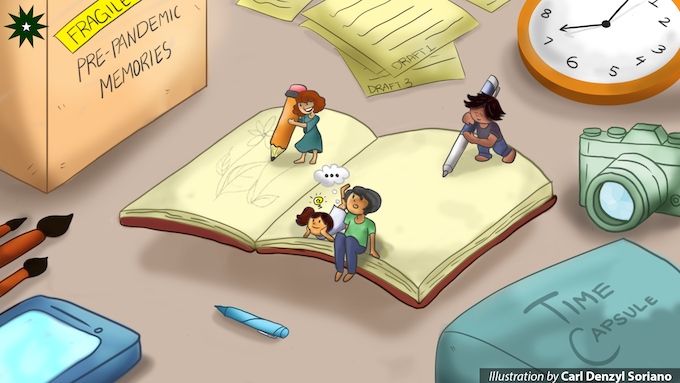
Readers mostly only see the tail-end of a long and laborious process. This emphasis on tangible results may sometimes leave artists entirely overlooked. After all, regardless of the artist, the art will have to stand on its own against the world.
But by doing so, an important aspect of art becomes sidelined. The unsung tales behind any piece of art often quietly fade into history.
For the Malate Literary Folio, or more commonly known to Lasallians as “Malate,” the journey is as important as the destination. As their current Editorial Board (EB) published their first folio as a team, a look into the ins and outs of the organization is only apt if one is to understand just how their folios end up to be.
A good place to start
A folio often starts when EB members ask for submissions from its staffers. From there, those eager to get published can send their artworks or literary pieces to their section editors for pre-selection. While Malate staffers are given the artistic freedom to choose if they want to submit for an upcoming folio, Mary Joy Abalos (III, AB-LIM), the Associate Editor and Prose Editor of the organization, reveals that for staffers who are new to Malate, “It’s actually a requirement for regularization to pass a draft. So, if they get published, then that counts as part of their regularization.”
Once all the pre-selected submissions have been finalized by the section editors, the grueling process of deliberation commences. This process dictates which pieces get published or postponed. Though the deliberation of works is rarely as simple as it sounds. Picking the appropriate artworks to be published often requires countless passionate discussions among the EB that could take hours across multiple days and via various platforms.
As the EB gradually finalizes the set of artworks for publication, only does the theme for the folio start to emerge, which is a different battle altogether. As Cathleen Madrid (III, AB-CAM), Malate’s Editor-in-Chief, succinctly encapsulates, “Ano ba iyong pinaka-common na theme sa lahat ng mga works na ito?” A simple question is often followed by another round of heated debates and introspection among the team before settling on a singular overarching theme.
(What’s the most common theme among these works?)
Challenge accepted
While the overall process may seem cut and dried, there are a couple of aspects that make it complex and at times overwhelming.
Madrid expresses how a healthy amount of disagreement breeds more holistic results. “Of course, ‘diba iba iyong perspectives namin, which is I think in a way, healthy rin kasi we were able to get different perspectives about works.”
(These different perspectives allow for a better deliberation of the pre-selected works.)
Artworks that get postponed are often saved for later folios or even special folios, while some just don’t make the cut. Even then, Managing Editor, Isabella Tuason (II, BS-ENT), points out that, “We always encourage our staffers that […] [they] still have other opportunities to get published in other folios.” Instead of focusing on rejection, Tuason emphasizes the importance of using such experiences as opportunities for growth.
Time, especially, is another hurdle for Malate staffers. The process of making the folio itself can be time-consuming, and add to the fact that Malate staffers are students with their own personal lives—time management becomes of the essence. “We have to give time for our [academic workload], you have to give time to rest,” Tuason imparts.
Then there’s the added challenge brought by the pandemic. Fluctuating internet bandwidth or unforeseen circumstances from one of the EB’s end occasionally disrupts the flow of what was once a passionate virtual discussion.
But as Abalos remarks, “These challenges in the online setup don’t stop us from having fruitful conversations since we know that these conversations are necessary. Our staffers worked hard on their own artworks and their literary pieces. It’s only proper for us to give them the same amount of attention.”
A personal invitation
With memory and personal experience as the central theme of this issue, Malate enjoins its readers to pause and indulge in the joys and heartaches of the past.
Whether as a means to cope with recent times or simply to reminisce, let Tomo XXXVII Blg. 1 act as a trinket of the past for its readers—a special novelty one holds dear, to remember what once was and what could still be. As Madrid aptly proclaims, “We all live in the same world, we almost go through the same things. But what makes it different is that we all have our own perspectives on it.”
Malate’s recent folio has been nothing short of monumental, not only due to the successful launch of the team’s first folio but also to the personal triumphs celebrated by its members. As Abalos professes, “I think […] what sets [this issue] apart from previous issues [is that] it’s a very intimate issue talaga.”
(It’s a really intimate issue.)
More than that, however, what truly demarcates this issue is the unique collection of artists that make up this folio. Alone, they can mold stunning works of art, but together, they created this distinctive story of reminiscence that represents the collective experiences of both the artists and the public during this COVID-19 pandemic. A story that is now forever immortalized in the pages of Malate’s Tomo XXXVII Blg. 1.
